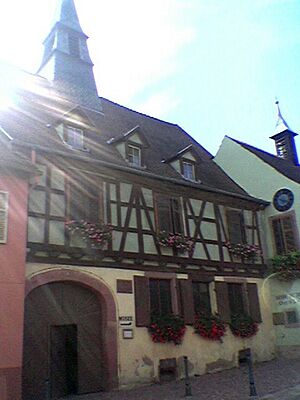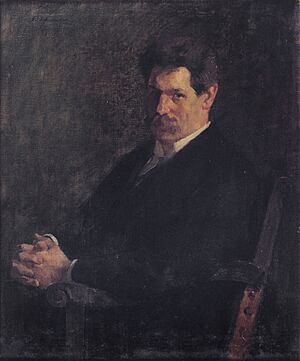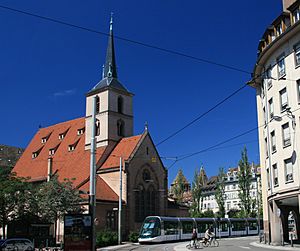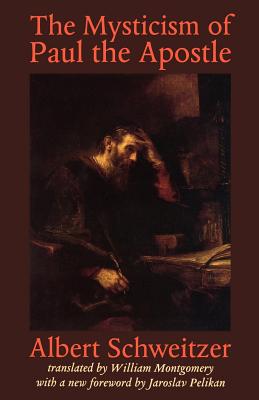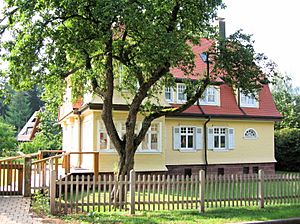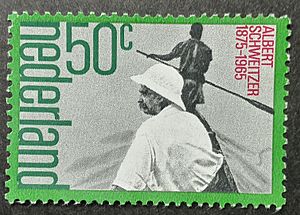Albert Schweitzer facts for kids
Quick facts for kids
Albert Schweitzer
|
|
|---|---|
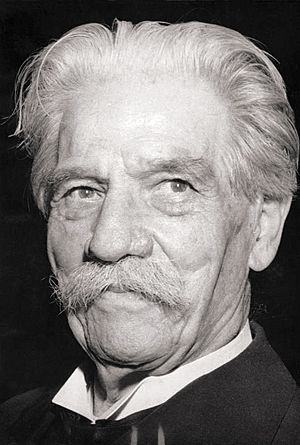
Schweitzer in 1955
|
|
| Born | 14 January 1875 |
| Died | 4 September 1965 (aged 90) Lambaréné, Gabon
|
| Citizenship |
|
| Alma mater | University of Strasbourg |
| Known for |
|
| Spouse(s) | Helene Bresslau |
| Awards |
|
| Scientific career | |
| Fields |
|
| Doctoral advisor |
|
| Influences | H. S. Reimarus |
| Influenced | Andrew Linzey |
Albert Schweitzer (born January 14, 1875 – died September 4, 1965) was a very talented person from Alsace, a region between France and Germany. He was a theologian (someone who studies religion), an organist (who plays the organ), a music expert, a writer, a humanitarian (someone who helps people), a philosopher (someone who thinks deeply about life), and a doctor.
As a Lutheran minister, Schweitzer had new ideas about Jesus. He also had different views on Paul's teachings, focusing on Paul's idea of "being in Christ" as most important.
He won the 1952 Nobel Peace Prize for his special idea called "Reverence for Life". This idea meant respecting all living things. He showed this philosophy by starting and running the Hôpital Albert Schweitzer in Lambaréné, Gabon, in Africa. He was also a great music scholar and organist, especially known for studying the music of Johann Sebastian Bach. He helped start the Organ Reform Movement, which changed how organs were built and played.
Contents
Early Life
Albert Schweitzer was born on January 14, 1875, in Kaysersberg, a town in Alsace. At that time, Alsace was part of the German Empire, but it had been French for over 200 years before that. After World War I, Alsace became French again, and Schweitzer became a French citizen.
He grew up in Gunsbach, Alsace, where his father was a Lutheran pastor. His father taught him to play music. The church in Gunsbach was shared by both Protestants and Catholics, who prayed at different times. This taught Schweitzer about religious tolerance from a young age. He believed that true Christianity should bring people together.
Schweitzer's first language was a German dialect spoken in Alsace. He finished high school in Mulhouse in 1893. He also studied organ there and was inspired by the music of Richard Wagner. In 1893, he met the famous French organist Charles-Marie Widor in Paris. Widor was very impressed and taught Schweitzer for free, starting a long and important friendship.
From 1893, Schweitzer studied theology (the study of religion) at the University of Strasbourg. He also learned piano and music theory. He served in the military for a year in 1894. He loved opera and even went to the Bayreuth Festival to see Wagner's famous operas. In 1898, he went to Paris to write his PhD paper on the philosophy of Immanuel Kant. He also continued his music studies with Widor. In 1899, he earned his theology degree.
In 1905, at age 30, Schweitzer decided to study medicine at the University of Strasbourg. He earned his medical degree in 1913.
Music Contributions
Schweitzer quickly became well-known as a music expert and organist. He was especially interested in old pipe organs and helping to restore them. He had a unique way of understanding Bach's religious music, seeing how Bach used musical pictures and symbols to show ideas from hymns.
In 1905, he wrote a famous book in French called J. S. Bach: Le Musicien-Poète. He later rewrote it in German, and it was translated into English in 1911. This book greatly changed how people understood Bach's music.
Schweitzer also helped start the Orgelbewegung (Organ Reform Movement) in the 20th century. This movement aimed to bring back older ways of building organs, moving away from the very grand "romantic" style. In 1909, he presented a report that led to the International Regulations for Organ Building, which set new standards for how organs should be made.
He also studied piano in Paris. In 1905, he helped create the Paris Bach Society, a choir that performed Bach's music. Schweitzer often played the organ for their concerts. He also worked with Widor on a new edition of Bach's organ music, writing detailed explanations for each piece.
When he left for Africa in 1913, he was given a special pedal piano. This was a piano with pedals like an organ, built to handle the tropical climate. He continued to play it in Lambaréné, often during lunch or on Sunday afternoons. Even when he was 88, he was still playing the old instrument.
Theology and Philosophy
In 1899, Schweitzer became a deacon at the church of Saint Nicholas in Strasbourg. In 1900, he became a curate (a type of minister). The next year, he became the head of the Theological College of Saint Thomas, where he had studied.
In 1906, he published a book called The Quest of the Historical Jesus. This book made him famous. In it, Schweitzer argued that people in Jesus's time, including Jesus himself, believed the world was going to end very soon. He looked at many parts of the New Testament that seemed to support this idea.
Schweitzer ended his book on Jesus with a famous passage: "He comes to us as One unknown, without a name, as of old, by the lake-side, He came to those men who knew him not. He speaks to us the same word: 'Follow thou me' and sets us to the task which He has to fulfill for our time. He commands. And to those who obey Him, whether they be wise or simple, He will reveal Himself in the toils, the conflicts, the sufferings which they shall pass through in His fellowship, and as an ineffable mystery, they shall learn in their own experience Who He is."
In 1931, he published The Mysticism of Paul the Apostle. In this book, Schweitzer explored different kinds of mysticism. He argued that Paul's main idea was "being in Christ," which meant a deep connection with Jesus, rather than just "justification by faith" (the idea that faith alone saves you), which was a popular teaching by Martin Luther. Schweitzer believed that for Paul, this "being in Christ" was a real experience of sharing in Jesus's death and resurrection, especially through Christian community and practices like baptism.
Medical Work in Africa
At age 30, in 1905, Schweitzer decided to become a doctor and work as a missionary in Africa. His friends and family were surprised, but he felt it was his calling. He wanted to help people through healing, believing this was a way to spread Christian values without just preaching. He thought this service would be accepted by all Christians.
He worked very hard and finished his medical studies in 1911. His medical paper was about Jesus' mental health, where he defended it. In 1912, he married Helene Bresslau, who was an inspector for orphans.
In 1912, with his medical degree, Schweitzer decided to go to Lambaréné in Gabon, Africa (which was then a French colony). He used money from his concerts and fundraising to buy equipment for a small hospital. In early 1913, he and his wife traveled to Africa to set up their hospital near an existing mission.
In their first nine months, they treated about 2,000 patients. Many people traveled for days to reach them. They treated many tropical diseases and injuries. Schweitzer's wife, Helene, helped as an anaesthetist during surgeries. They first used a chicken shed as a hospital, then built their first proper hospital building in late 1913. They also built a waiting room and dormitories like local huts. They had a local assistant named Joseph.
When World War I started in 1914, Schweitzer and his wife, being German citizens in a French colony, were put under watch. But Schweitzer continued his work. In 1917, tired and sick, they were sent to France and held in camps. In 1918, he was released and returned to Alsace. He became a French citizen. He worked as a medical assistant and pastor in Strasbourg while developing his ideas on the philosophy of civilization. By 1920, his health was better, and he gave organ concerts to raise money to return to Gabon. In 1924, he went back to Lambaréné without his wife.
The hospital buildings had fallen apart, so he started rebuilding and treating patients at the same time. More medical staff joined him. In 1925–26, new hospital buildings were constructed, making the site look like a small village. He returned to Europe in 1927, leaving a working hospital behind. He continued to travel back and forth between Europe and Lambaréné for many years, even staying there throughout World War II.
Hospital Conditions and Views on Colonialism
Some visitors to the hospital, like journalist James Cameron in 1953, noted that the hospital was very basic and didn't have all the modern facilities found in Europe. They also observed that Schweitzer had limited interaction with the local people in some ways.
Schweitzer was very critical of colonialism. He believed that European countries had treated people in other parts of the world unfairly. In a sermon in 1905, he said that "civilized men" often ignored the dignity and rights of people in other countries, especially those with different skin colors. He felt that Europeans needed to make up for the wrongs committed under colonialism by helping those they had harmed.
However, some people felt that Schweitzer's attitude towards Africans was still somewhat paternalistic. He once said, "The African is indeed my brother but my junior brother." This meant he saw Africans as needing guidance, like younger siblings. While this idea was seen as progressive for his time because he called them "brothers" at all, it also showed a belief that Africans were not yet ready for full independence or self-governance. Later in his life, he changed this view, saying, "The time for speaking of older and younger brothers has passed."
Reverence for Life
The most important part of Schweitzer's personal philosophy was the idea of Reverence for Life (Ehrfurcht vor dem Leben). He believed that Western society was losing its way because it had forgotten to value all life as its main ethical principle.
He wrote that true philosophy should start with the simple fact: "I am life which wills to live, and I exist in the midst of life which wills to live." This means that every living thing wants to live. While in nature, one life often has to use another to survive, humans, with their awareness, should try to respect the will of other beings to live as much as possible.
For Schweitzer, humans needed to understand that the world itself doesn't have built-in ethics. It's up to humans to create moral rules and build a good civilization. Respecting all life, and overcoming selfish desires, leads people to help others and every living creature. This respect for life becomes the highest goal and purpose for humanity.
Schweitzer tried to live by this philosophy in his own life. Some people believe his idea of "Reverence for Life" was influenced by Indian ideas, especially the Jain principle of ahimsa, which means non-violence. He also admired the ancient Indian book, the Tirukkural, which teaches about not killing or harming and doing good for its own sake.
Later Life and Legacy
After their daughter, Rhena, was born, Albert's wife, Helene, could no longer live in Lambaréné due to her health. In 1923, the family moved to Königsfeld im Schwarzwald, Germany, where Schweitzer built a house for them. This house is now a museum.
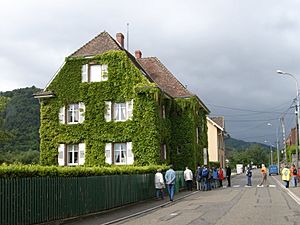
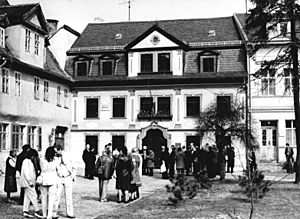
From 1939 to 1948, he stayed in Lambaréné because of World War II. After the war, he traveled back and forth between Africa and Europe (and once to the US). When he visited his home village of Gunsbach, he stayed in the family house, which is now an archive and museum. His life was shown in the 1952 movie Il est minuit, Docteur Schweitzer.
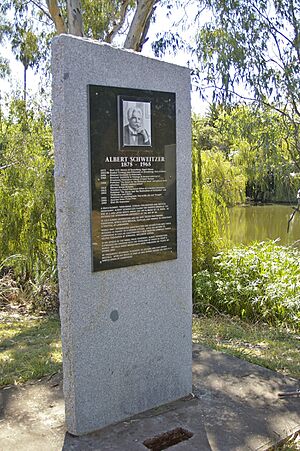
Schweitzer received the Nobel Peace Prize in 1952. He used the prize money to start a leprosarium (a place for people with leprosy) at Lambaréné. From 1952 until his death, he worked with famous people like Albert Einstein and Bertrand Russell against nuclear tests and nuclear weapons. In 1957 and 1958, he gave speeches on Radio Oslo, asking for nuclear weapons to be abolished.
Albert Schweitzer died on September 4, 1965, at his hospital in Lambaréné, Gabon. His grave, by the Ogooué River, has a cross he made himself.
The Albert Schweitzer Fellowship was started in 1940 to support his hospital. Today, it continues to help the Lambaréné Hospital and also helps young Americans in health-related fields find ways to serve others, inspired by Schweitzer's idea of "Reverence for Life."
International Albert Schweitzer Prize
This prize was first given out on May 29, 2011, in Königsfeld im Schwarzwald, where Schweitzer's former home is now a museum.
Sound Recordings
Albert Schweitzer made recordings of himself playing Bach's music on the organ. These recordings were made in the 1930s in London and Strasbourg.
Portrayals
Schweitzer's life has been shown in several films and TV shows:
- The 1952 film Il est minuit, Docteur Schweitzer, with Pierre Fresnay as Schweitzer.
- The 1957 film Albert Schweitzer, where Schweitzer appeared as himself.
- The 1990 film The Light in the Jungle, with Malcolm McDowell as Schweitzer.
- Two episodes of The Young Indiana Jones Chronicles in 1992, with Friedrich von Thun as Schweitzer.
- The 1995 film Le Grand blanc de Lambaréné, with André Wilms as Schweitzer.
- The 2006 TV film Albert Schweitzer: Called to Africa, with Jeff McCarthy as Schweitzer.
- The 2009 film Albert Schweitzer, with Jeroen Krabbé as Schweitzer.
See Also
 In Spanish: Albert Schweitzer para niños
In Spanish: Albert Schweitzer para niños
- List of peace activists
- Cultural depictions of Albert Schweitzer
- Helene Bresslau Schweitzer
Images for kids


